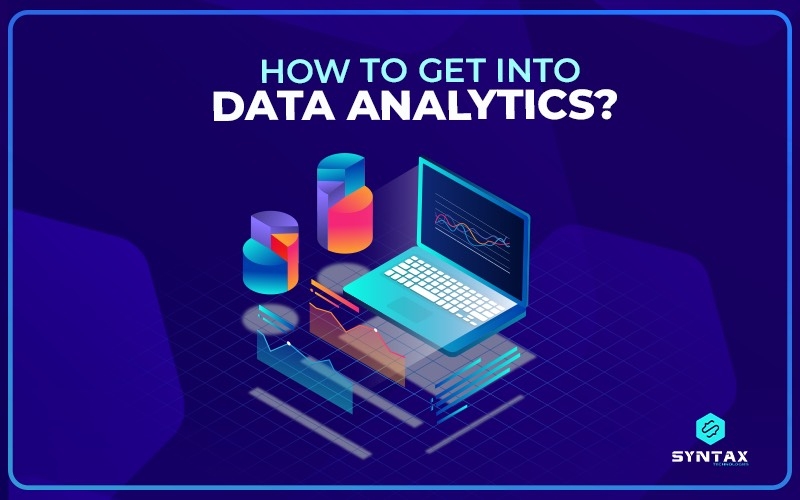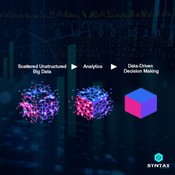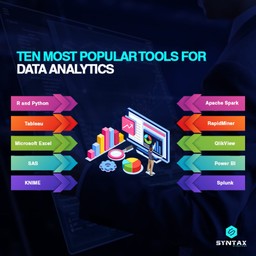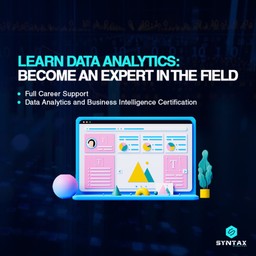Data analytics is a rapidly growing field that offers immense potential for those looking to pursue an exciting career in data analysis. With the rise of big data and the increasing demand for data-driven insights, the demand for skilled data analysts is on the rise. With the right tools, training, and expertise, anyone can get into Data Analytics and start making valuable contributions to businesses and organizations in the capacity of a Data Analyst.
In this blog post, we’ll explore how you can enter the world of data analytics ? from exploring degree programs, certifications, and available job opportunities ? to gain proper data analytics skills needed to succeed in this dynamic field. We?ll also provide tips on where to start your research and point out resources you can use along the way. So let’s dive in!
Understand the fundamentals of Data Analytics
Data analytics is the science of analyzing raw data with the aim of discovering patterns, uncovering insights, and making informed decisions. It involves a range of techniques, from basic statistical analysis to more advanced machine learning algorithms.
The goal of Data Analytics is to extract meaningful insights from large datasets in order to gain a better understanding of trends and correlations which can then be used for decision-making purposes.
In order to become an effective data analyst, it?s important to understand key concepts such as predictive modeling, regression analysis, hypotheses testing, clustering algorithms and supervised/unsupervised learning.
It’s also essential to have a good knowledge of leading data analysis platforms and software programs like Python, R or SQL, and be familiar with data visualization tools such as Tableau or PowerBI.
Knowing the fundamentals of Data Analytics will help you develop a better understanding of the different types of data analysis, enabling you to make informed decisions in your role as a data scientist.
Articles you may like:
“How to become a Big Data Analyst“
“How to become a Data Analyst with No Experience“
“How to become a Data Analyst without a Degree“
Learn how to Analyze data and Interpret data sets
Once you understand the fundamentals of Data Analytics, it’s time to learn how to analyze data and interpret data sets. This involves understanding Descriptive, Predictive and Prescriptive analytics ? three key types of analyses used by analysts.
The purpose of Descriptive Analytics is to summarize raw data in order to identify patterns and highlight insights from the dataset. Predictive Analytics helps us make predictions about future outcomes based on past trends, while Prescriptive Analytics uses advanced algorithms and models to provide recommendations or solutions for a given problem.
By mastering these techniques, you will be able to effectively derive meaningful insights from complex datasets and make informed decisions.
Learn the fundamentals of Programming Languages such as Python, R, and SQL
Learning the fundamentals of programming languages such as Python, R, and SQL is critical for data analyst skills development and technical skills mastery.
These programming languages are widely used in the field of Data Analytics to extract, manipulate, and analyze data. As a data analyst, proficiency in these programming languages is important for data wrangling, data visualization, and statistical analysis.
Python and R are popular choices for data analysts because they have robust libraries for data manipulation and statistical analysis, and are also widely used for machine learning applications. SQL, on the other hand, is essential for data analysts working with databases, as it is used to extract data from relational databases.
By mastering these programming languages, data analysts can improve their efficiency, effectiveness, and accuracy when working with data, and can also improve their communication with stakeholders who may not have technical expertise.
In today’s data-driven world, proficiency in programming languages is an essential skill for aspiring data analysts to succeed in the field.
Familiarize yourself with relevant Software and Tools used by Data Analysts
In addition to having a good understanding of the fundamentals of Data Analytics and programming languages, it’s important for data analysts to be familiar with the relevant software and tools that are used within the field.
Commonly used software and data analysis tools include Tableau, PowerBi, Excel, SQL Server Management Studio (SSMS), and Amazon Web Services (AWS). Proficiency in the usage of these tools constitute an important component essential data analysis skills.
These software and tools enable data analysts to manipulate, visualize, analyze and interpret large datasets quickly. Familiarity with these tools can help data analysts work more efficiently when dealing with complex datasets in order to derive meaningful insights for decision-making purposes.
Data Analysts also need to understand how different databases store information so that they can effectively query them. For example, knowledge of Structured Query Language (SQL) is necessary for manipulating and retrieving data from relational databases.
Acquire knowledge in Data Mining, Machine Learning, and Artificial Intelligence
Data Science, Machine Learning and Artificial Intelligence are relatively new fields of study that have become increasingly important in the data analysis field.
Data Mining is a process used to extract meaningful information from large datasets so that it can be used for further analysis. Machine Learning algorithms are used to identify patterns and make predictions from large datasets.
Artificial Intelligence (AI) uses advanced computer algorithms to enable machines to carry out tasks usually associated with human intelligence such as decision-making and problem solving.
Knowledge of Data Mining techniques such as clustering, association rule mining and classification will allow analysts to find hidden patterns in data sets.
Machine learning algorithms such as neural networks, decision trees and support vector machines can be used to make predictions from large datasets.
Finally, knowledge of artificial intelligence technologies will enable data analysts to incorporate AI-driven solutions into their analysis.
By mastering these skills, Data Analysts will be better equipped for making sound data-driven decisions that are essential for the success of any organization.
Get Experience by practicing with sample datasets and applying Analytical Techniques to them
Gaining hands-on experience is essential to mastering the data analysis skills required of a successful data analyst. It is important for aspiring data analysts to familiarize themselves with sample datasets and practice their analytical skills by applying various analytical techniques to them.
This will help them develop proficiency in extracting meaningful insights from different types of datasets. Doing so will equip them with the data skills to analyze larger real-world datasets when they work in a data analyst job.
In addition, practicing with sample datasets can also help familiarize data analysts with different types of software and tools used in the field. By doing this, they can get first-hand experience on how these tools can be used to manipulate, visualize and analyze data sets quickly and effectively.
Cultivating relevant Soft Skills
In addition to technical skills, data analysts also need to possess soft skills to be successful in their data analyst roles. Soft skills such as critical thinking, problem-solving and communication skills are essential for carrying out effective analysis.
Data Analysts must have the ability to think critically and identify analytical opportunities that can provide useful insights into complex datasets.
They must also have strong problem-solving skills to develop strategies and solutions when dealing with difficult data challenges. Finally, Data Analysts should be able to communicate their findings clearly and effectively so that business leaders can understand the implications of the analysis for their decision making.
Developing these soft skills will enable aspiring data analysts to become more valuable contributors in any data-driven organization or project.
Consider pursuing an Online or Traditional Degree in Data Analytics if you want further qualifications and certifications
Earning a degree in Data Analytics is one way for individuals to further enhance their qualifications and certifications. There are many online or traditional degrees available, such as an Associate’s Degree in Data Analytics, Bachelor’s Degree in Data Science, Master’s Degree in Analytics and Big Data, etc.
These specialized courses allow students to gain a comprehensive understanding of the fundamentals of data analytics and equip them with the necessary skills to become successful analysts.
Additionally, obtaining certifications such as Certified Analytics Professional (CAP) or Certified Business Intelligence Professional (CBIP) can demonstrate proficiency in this field and open more opportunities for career advancement. Completing these courses and getting certified will help demonstrate competency in the Data Analytics field.
Data Analytics bootcamps are another great way for aspiring data analysts to gain the knowledge and skills needed for success in the field. Bootcamps provide an intensive learning experience that covers all the core concepts of Data Analytics from collecting, cleaning, visualizing and analyzing large datasets; to building predictive models with machine learning algorithms.
We, at Syntax Technologies, provide you with the exciting opportunity of developing data analysis abilities and skills in consonance with that of most data analysts. Enroll today for our Data Analytics and Business Intelligence course.
Network regularly with Data Professionals working in the industry and attend relevant events to stay up-to-date on trends (H3)
Networking with data professionals in the industry is key for staying up-to-date on trends. By attending relevant events and conferences, data analysts can gain valuable insights that help them stay ahead of the curve.
Additionally, networking with industry experts allows aspiring data analysts to gain a better understanding of the tools and techniques used by experienced professionals in their day-to-day work.
Furthermore, connecting with other data professionals provides opportunities for entry level data analysts to collaborate on projects or join forces to create new solutions which helps develop a strong data analyst portfolio.
Finally, building relationships with fellow data scientists can lead to job referrals and make finding employment easier. Therefore, taking advantage of these networks will be beneficial for any aspiring data analyst looking to kickstart their career in this rapidly growing field.
Conclusion
In conclusion, Data Analytics is a rapidly growing field and those who want to become successful data analysts must develop strong technical and soft skills.
Pursuing an online or traditional degree in Data Analytics can provide individuals with the qualifications they need to succeed. Additionally, participating in bootcamps or networking events can help aspiring data analysts gain valuable insights from experienced professionals in the industry.
With dedication and hard work, anyone can become a successful data analyst.
At Syntax Technologies, we provide quality training and mentoring to help aspiring data analysts build a successful career in this field. Reach out to us and take advantage of our Data Analytics and Business Intelligence course today!




